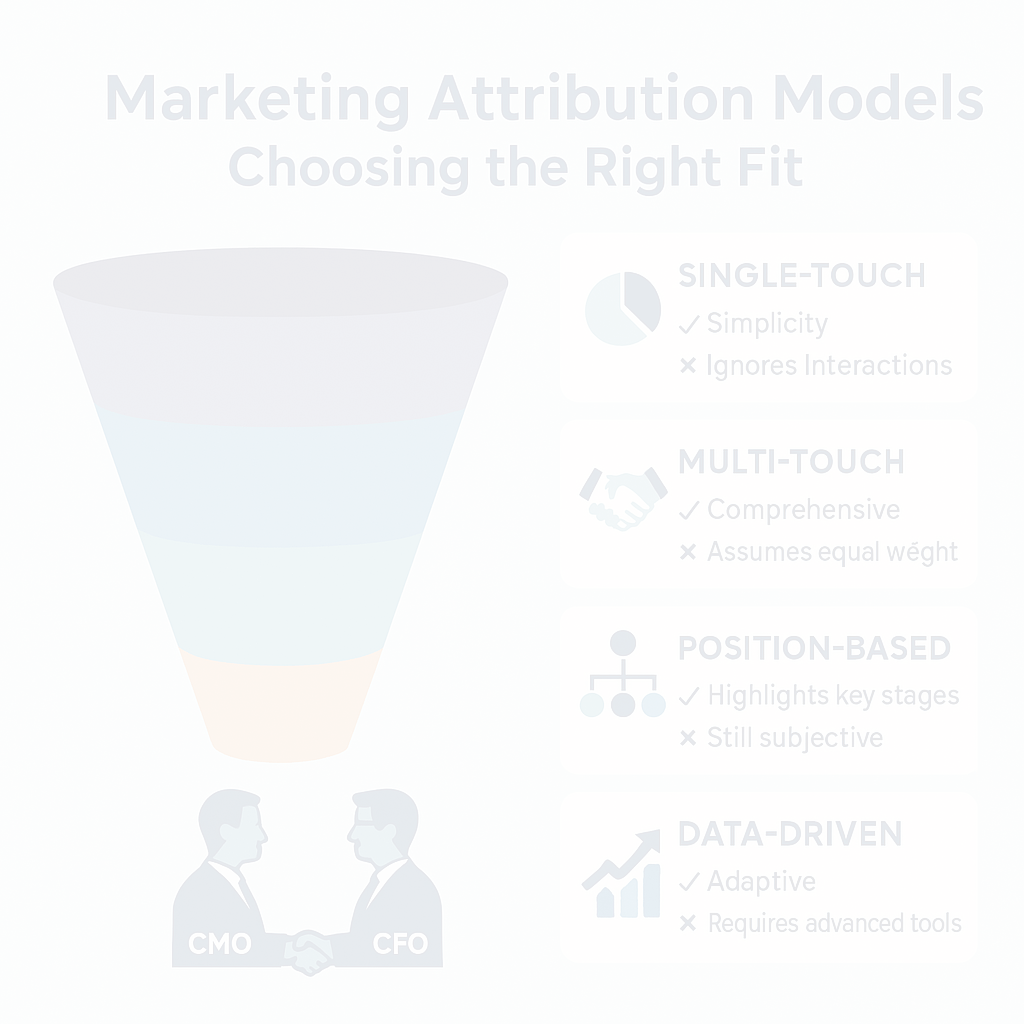Why the Attribution Conversation Matters
In the audio session, Angela Winegar (Head of Growth, Carta) frames marketing as “capital allocation” rather than cost-centred spend; every channel touchpoint is an investment that must earn its keep, and attribution modelling is the ledger that proves it. Snipd
Yet up to 40 % of marketing budgets are misallocated because the wrong model overcredits the “easy” last click – a drag that can run to hundreds of billions globally. bluealpha.ai The pressure is rising: only 35 % of CMOS say they work closely with finance today, down from 42 % last year, even though both sides agree revenue goals depend on it. CMO Alliance
Attribution 101: Single-Touch vs. Multi-Touch
| Model family | Core idea | When it shines | Key risk |
| First-touch | 100 % credit to the very first interaction | Early-stage brand-awareness or lead-gen campaigns | Ignores everything that nudges prospect to buy |
| Last-touch | 100 % credit to the final interaction before conversion | Short cycles where the last step is the decider (e.g., flash sales) | Starves always-on upper-funnel activity |
| Linear (multi-touch) | Equal credit to every recorded touchpoint | Simple starter model for long, research-heavy journeys | Over-represents low-impact touches |
| Time-decay | More weight the closer the touch is to conversion | Consideration cycles with strong down-funnel “activators” | Discounts brand seasoning that happens months earlier |
| Position-based (U & W shapes) | Split weight across first/last (+ mid in W-shape) | SaaS or B2B motions where discovery & decision moments dominate | Still subjective weighting |
| Custom / rule-based | Your own weighting rules | Mature teams that can encode known journey truths | Hard to maintain as behaviour shifts |
Definitions & examples adapted from Aimtal and Emfluence explainers. aimtal.comemfluence Digital Marketing
Enter the Algorithm: Data-Driven & Incrementality Models
Google Analytics 4 now defaults to data-driven attribution (DDA), using machine-learning to redistribute credit based on thousands of historical paths – the old first-click and time-decay presets were formally retired in Nov 2023. Google Help
CFOs, however, are asking for the causal truth:
- Marketing-mix modelling (MMM) for a channel-level, offline-plus-online lens.
- Incrementality testing (geo-split, holdout cells, PSA “ghost ads”) is used to isolate the causes of lift in your spending versus what would have happened anyway. bluealpha.ai
These advanced methods complement—but do not replace—daily platform-level attribution; together they form a measurement “stack” that satisfies both growth teams and finance controllers.
Five Filters for Picking Your Model
- Sales-cycle length & complexity – Long B2B journeys merit multi-touch or DDA; a three-click impulse buy might survive on last-touch.
- Channel diversity – The more surfaces (search, paid social, events, SDR outreach), the more you need a model that rewards joint contribution.
- Data maturity – Clean CRM-integrated touch logs are mandatory before you trust any algorithm. Aimtal stresses CRM integration as the first practical step. aimtal.com
- Org culture & skills – If analysts can’t explain coefficients to stakeholders, stick with rule-based models you can describe on one slide.
- Regulatory & privacy limits – Heavier weighting on aggregated MMM or server-side conversion APIs may be unavoidable as third-party cookies sunset.
Implementation Playbook
- Pipe every channel into your CRM/warehouse. No attribution model will fix siloed data. aimtal.com
- Standardise UTMs & campaign naming. Discrepancies here snowball into broken paths and “unknown” traffic.
- Hunt for “dark social.” Pair link shorteners with form fields (“How did you hear about us?”) to surface Slack shares and DMs that never leave a cookie trail. aimtal.com
- Dashboards for both CMO and CFO. Blend marketing metrics (CAC, pipeline velocity) with finance ratios (payback period, gross margin) so everyone argues from the same sheet. CMO Alliance
- Iterate quarterly. Treat the attribution model itself as a living product: review edge-case deals, compare with lift tests, and tweak weights or channel definitions.
Speaking the Language of Finance
Winegar’s core thesis—marketing spend is capital—means marketers must forecast returns the way investors do: expected value, risk, time horizon. Snipd
- Tie attribution outputs directly to profit metrics (e.g., contribution margin after paid spend).
- Publish “earned ΔROI” scores that show how reallocating budget, validated by MMM or incrementality, will lower CAC or boost LTV.
- Run joint CMO–CFO quarterly reviews; the CMO Alliance survey shows transparency beats misalignment and reduces budget cuts. CMO Alliance
The Road Ahead
Attribution is converging on three trends:
- Privacy-preserving modelling (GA4 DDA, aggregate conversions).
- AI-assisted scenario planning that projects ROI before spend.
- Finance-grade experimentation where lift tests, not platform pixels, have the final say.
Mastering the fundamentals—selecting the right attribution model, cleaning your data, and aligning insights with finance goals—positions your team to ride each wave rather than scramble.
So, start with the simplest model that answers your biggest budget question, instrument rigorously, and invite your CFO to the dashboard demo. You’ll both speak the same language—and you’ll both be able to prove which dollars drive growth.
— End of article


